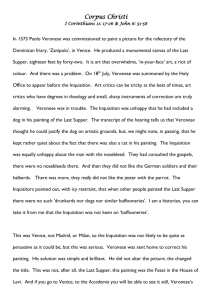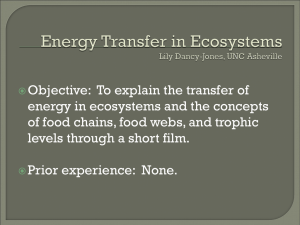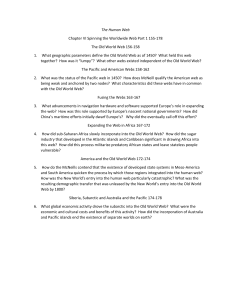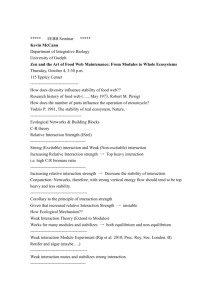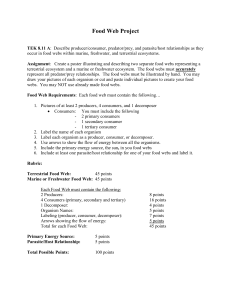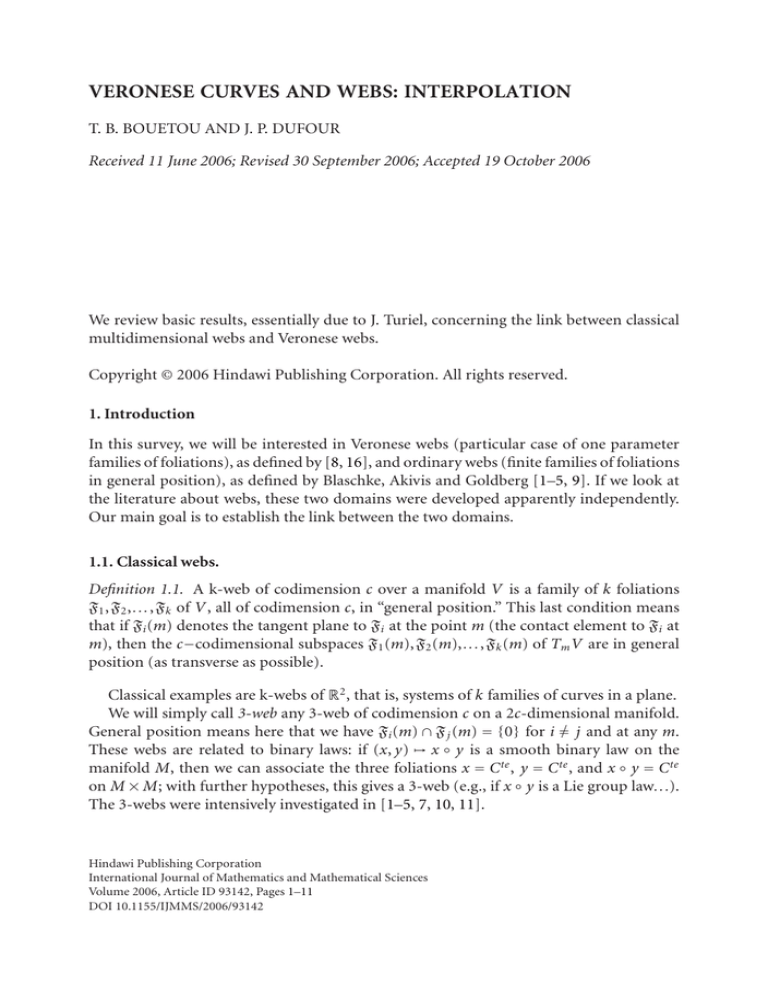
VERONESE CURVES AND WEBS: INTERPOLATION
T. B. BOUETOU AND J. P. DUFOUR
Received 11 June 2006; Revised 30 September 2006; Accepted 19 October 2006
We review basic results, essentially due to J. Turiel, concerning the link between classical
multidimensional webs and Veronese webs.
Copyright © 2006 Hindawi Publishing Corporation. All rights reserved.
1. Introduction
In this survey, we will be interested in Veronese webs (particular case of one parameter
families of foliations), as defined by [8, 16], and ordinary webs (finite families of foliations
in general position), as defined by Blaschke, Akivis and Goldberg [1–5, 9]. If we look at
the literature about webs, these two domains were developed apparently independently.
Our main goal is to establish the link between the two domains.
1.1. Classical webs.
Definition 1.1. A k-web of codimension c over a manifold V is a family of k foliations
F1 , F2 ,..., Fk of V , all of codimension c, in “general position.” This last condition means
that if Fi (m) denotes the tangent plane to Fi at the point m (the contact element to Fi at
m), then the c−codimensional subspaces F1 (m), F2 (m),..., Fk (m) of Tm V are in general
position (as transverse as possible).
Classical examples are k-webs of R2 , that is, systems of k families of curves in a plane.
We will simply call 3-web any 3-web of codimension c on a 2c-dimensional manifold.
General position means here that we have Fi (m) ∩ F j (m) = {0} for i = j and at any m.
These webs are related to binary laws: if (x, y) → x ◦ y is a smooth binary law on the
manifold M, then we can associate the three foliations x = C te , y = C te , and x ◦ y = C te
on M × M; with further hypotheses, this gives a 3-web (e.g., if x ◦ y is a Lie group law...).
The 3-webs were intensively investigated in [1–5, 7, 10, 11].
Hindawi Publishing Corporation
International Journal of Mathematics and Mathematical Sciences
Volume 2006, Article ID 93142, Pages 1–11
DOI 10.1155/IJMMS/2006/93142
2
Veronese curves and webs: interpolation
More generally, a (p + 1)-web will be a (p + 1)-web of codimension c on a manifold of
dimension pc. Here general position means that, for all m ∈ V , we have
F1 (m) ∩ · · · ∩ Fi−1 (m) ∩ Fi+1 (m) ∩ · · · ∩ F p+1 (m) = {0},
(1.1)
for any i = 1,..., p + 1.
Remark 1.2. A p-web of codimension c on a manifold of dimension pc is locally trivial,
that is, we can find local coordinates
p
p
x11 ,...,xc1 ,...,x1 ,...,xc ,
(1.2)
where Fi is given by the equations {x1i = C te ,...,xci = C te }. So the first webs which have an
interesting local geometry are the above-defined (p + 1)-webs.
1.2. Veronese webs.
Definition 1.3. Let V be a real vector space of dimension (n + 1). A Veronese curve in the
projective space P(V ) is a map
γ : P1 R −→ PV
(1.3)
which is the quotient of a map of the type
(x, y) −→ xn vn + xn−1 yvn−1 + · · · + y n v0 ,
(1.4)
where (v0 ,v1 ,...,vn ) is a base in V .
Definition 1.4 (see [8, 13, 18]). A Veronese web of codimension c on a manifold V of
dimension pc is a one-parameter family of foliations (Ft )t∈P1 R of codimension c on V
such that, for all m in V , the contact element Ft (m) is given by
α1t = 0,...,αct = 0
(1.5)
αit = γ0i + tγ1i + t 2 γ2i + · · · + t p−1 γip−1 ,
(1.6)
with
form a local coframe; that is,
where (γij )ij==1,...,c
0,...,p−1
γ01 ,...,γ1p−1 ,γ02 ,...,γ2p−1 ,...,γ0c ,...,γcp−1
(1.7)
are differential forms, defined in a neighborhood of m such that
γ01 (m),...,γ1p−1 (m),...,γ0c (m),...,γcp−1 (m)
is a basis of Tm V .
(1.8)
T. B. Bouetou and J. P. Dufour 3
Gelfand and Zakharevich [8] defined Veronese webs of codim 1 (c = 1) and the notion
was generalized by A. Panasyuk and J. Turiel. In the sequel, we will sketch the way these
notions appeared.
In the bihamiltonian “mechanics,” we study pencil of Poisson structures Π0 + tΠ∞ over
a manifold W. This means that (see [8]) Πt = Π0 + tΠ∞ are Poisson structures for all t
and Π∞ is also a Poisson structure. It is equivalent to say that Π0 and Π∞ are Poisson
structures with [Π0 ,Π∞ ] = 0 ([·, ·] is the so-called Schouten bracket); in that case we say
that Π0 and Π∞ are “compatible.”
For some time it was believed that any integrable Hamiltonian system was a bihamiltonian system, that is, there exists a second Poisson structure compatible with the Poisson structure related to the initial symplectic structure, which should be invariant by the
Hamiltonian field. The correct idea is that any bihamiltonian system is integrable but
Brouzet [6] has shown that the former belief was wrong. Nevertheless the classical integrable systems are all bihamiltonian.
Turiel [15] has classified the pairs of compatible Poisson structures (Π0 ,Π∞ ) with Π0
symplectic (here we are in an even-dimensional situation). On the other hand, I. Gelfand
and I. Zakharevich were the first to investigate the odd-dimensional case. Precisely, they
consider a pencil
Πt = Π0 + tΠ∞
(1.9)
on a 2p − 1-dimensional manifold such that Πt is, for all t, of maximum rank (2p − 2).
The symplectic foliation Ft of Πt is then of codimension 1 and locally given by the zeros
of a form αt . It is not yet a Veronese foliation in the sense of Definition 1.4, but we will
explain hereafter that it is the case up to a quotient.
In fact, we have the following local models:
Π0 (m) = e1 ∧ f1 + e2 ∧ f2 + · · · + e p−1 ∧ f p−1 ,
Π∞ (m) = f1 ∧ e2 + f2 ∧ e3 + · · · + f p−1 ∧ e p ,
(1.10)
where e1 ,...,e p , f1 ,..., f p−1 is a well-chosen base of Tm V ; denote by e1∗ ,... ,e∗p , f1∗ ,..., f p∗−1
the dual base of Tm∗ V . The distribution Ft (m) is the symplectic foliation of
Πt (m) = e1 ∧ f1 + e2 ∧ f2 + · · · + e p−1 ∧ f p−1 + t f1 ∧ e2 + f2 ∧ e3 + · · · + f p−1 ∧ e p .
(1.11)
It is easy to see that the distribution annihilates the form
βt = e∗p + te∗p−1 + · · · + t p−1 e1∗
(1.12)
and that Ft (m) contains f1 ,..., f p−1 .
Take a submanifold V of dimension p transverse to f1 ,..., f p−1 , the traces of Ft on
V form a Veronese web of codim 1 defined by
αt = e∗p + te∗p−1 + · · · + t p−1 e1∗ .
(1.13)
The theory initiated by Gelfand-Zakharevitch and ended by J. Turiel says that the local
invariants of the pair (Π0 ,Π∞ ) are the local invariants of this Veronese foliation restricted
4
Veronese curves and webs: interpolation
to V . Latter, the pairs (Π0 ,Π∞ ) such that Πt is of constant corank c > 1 where investigated and, by the use of the same method, one obtain Veronese webs in the sense of
Definition 1.4.
2. Link between (p + 1)-webs and Veronese webs
Let (Ft )t be a Veronese web of codimension c over the pc-dimensional manifold V . Assume that t1 ,...,t p+1 are two by two distinct then (Fti )i=1,...,p+1 gives a (p + 1)-web. In fact,
(Fti ) is locally given by
α1ti = 0,...,αcti = 0,
(2.1)
αit = γ0i + γ1i t + · · · + γip−1 t p−1 .
(2.2)
with
Since
1
1
.
.
.
1
ti1
ti2
..
.
ti p
ti1 p −1 · · · ti2 ..
.. .
. p −1 · · · ti p ···
p −1
(2.3)
is a Van Der Monde determinant, it is clear that
α1ti1 ,...,αcti1 ,...,α1ti p ,...,αcti p
(2.4)
form a base of T ∗ V for all i1 ,...,i p , two by two distinct with {i1 ,...,i p } ⊂ {1,..., p + 1},
therefore we have the condition of general position.
The most difficult problem is the passage from the (p + 1)-webs to Veronese webs. We
have a problem of interpolation of (Fi )i=1,...,p+1 to a curve (Ft )t∈P1 R having good properties. We decompose this into two problems.
Algebraic interpolation. Given p + 1 subspaces of codimension c in a pc-dimensional vector space V in general position, find a natural curve of subspaces of codimension c in V
passing through the given p + 1 subspaces. It is a problem in Gc (V ) the Grassmannian of
subspaces of codimension c in V . Let us assume that this problem has a unique solution.
Given p + 1 distributions of codimension c on a manifold of dimension pc, there would
exist a natural method to interpolate these p + 1 distributions F1 , F2 ,..., F p+1 in a curve
Ft of distributions.
Integrability. Under which condition these distributions are integrable? For example, is
the integrability of F1 , F2 ,..., F p+1 sufficient to guaranty that of Ft for all t?
In the next sections, we will investigate these questions.
T. B. Bouetou and J. P. Dufour 5
3. Interpolation of a finite family of subspaces
Let V be a vector space and Gc (V ) the Grassmannian of its codimension c subspaces. We
put N = dimV − c and denote by Sc (V ) the open subset of V N formed by N-uples of
linearly independent vectors of V . Let β : P1 R → Gc (V ); it is said to be a degree q curve if
it pulls back as follows:
β : R2 \ 0 −→ Sc (V ),
y) = β1 (x, y),...,βN (x, y) ,
β(x,
(3.1)
where βi has the form
βi =
j
βi (x, y)e j ,
(3.2)
j
j
(e j ) j is a basis of V , and βi are homogeneous polynomials of degree q; we have the following commutative diagram:
R2 \ 0
β
P
P1 R
Sc (V )
(3.3)
P
β
Gc (V )
where P are canonical projections (P(v1 ,...,vn ) = v1 ,...,vn ).
Let F1 ,...,F p+1 be given points of Gc (V ); we will say that β : P1 R → Gc (V ) is a minimal interpolation of (F1 ,...,F p+1 ) if β is a curve of minimal degree q passing through
F1 ,...,F p+1 .
It is a difficult problem to find such minimal interpolations and see if they are unique:
in general it is wrong. Furthermore, these curves are not independent of the choice of the
parametrization: the sequences of ti such that β(ti ) = Fi . In the sequel, we will show that
there are unique minimal interpolations in two important cases:
(i) the case where dimV = pc (dimFi = (p − 1)c),
(ii) the case where dimV = pN (dimFi = N).
In the first case, the minimal interpolations are pencils, that is, degree 1 curves, of ccodimensional subspaces; in the second case we recover Veronese curves and their generalization. Moreover, these cases are dual to each other.
3.1. Interpolation by pencils. In this section, we deal with a family F1 ,...,F p+1 of ccodimensional subspaces of the pc-dimensional vector space V . We suppose that this
family is in general position: this means that, for every i, we have F1 ∩ · · · ∩ Fi−1 ∩ Fi+1 ∩
· · · ∩ F p+1 = {0}.
Fix a system of linear coordinates (x11 ,...,x1c ; x21 ,...,x2c ; ... ; x1p ,...,xcp ) such that the
1
c
1
equations
of
F
i are xi = 0,...,xi = 0 for i = 1,..., p, and F p+1 has equations
i xi = 0,...,
c
x
=
0.
We
denote
by
i i
the corresponding basis.
e11 ,...,e1c ; e21 ,...,e2c ; ... ; e1p ,...,ecp
(3.4)
6
Veronese curves and webs: interpolation
We fix also a system t1 ,...,t p of two by two different real numbers.
A pencil of c-dimensional subspaces is a degree 1 curve β of c-dimensional subspaces
y) = (xa1 +
of V : this means that β pulls back as a curve β : R2 \ 0 → Sc (V ) with β(x,
1
(p
−1)c
(p
−1)c
j
j
+ yb
), where a and b are vectors of V . With the identification t ≡
yb ,...,xa
[t : 1], we can write β(t) = (G − tId)β(∞), where β(∞) is the space generated by the a j
and G : V → V is any linear map such that G(a j ) = −b j for every j.
We want to interpolate the Fi by such a pencil. More precisely, we want a pencil β with
β(ti ) = Fi , for i = 1,..., p and β(∞) = F p+1 . A simple solution is obtained by choosing G
j
j
such that G(ei ) = ti ei for every i = 1,..., p and j = 1,...,c we have
j
j
β(∞) = e p − ek ; k = 1,..., p − 1; j = 1,...,c ,
(3.5)
then
β(t) =
j
j
t p − t e p − tk − t ek ; k = 1,..., p − 1; j = 1,...,c ,
(3.6)
and it is easy to see that β(ti ) has equations xi1 = 0,...,xic = 0.
In the sequel, we will investigate the uniqueness of this pencil.
First we will suppose there is another linear map G with (G − ti Id)(F p+1 ) = Fi for
every i = 1,..., p. Put
j
j
j
G e p − ek := uk =
r =1···c,s=1··· p
jr
aks esr .
(3.7)
j
Then equations xr (usi − tr (esp − eis )) = 0 for every s, j = 1,...,c, i = 1,..., p − 1 and r =
1,..., p lead to
j
j
j
uk = t p e p − tk ek
(3.8)
for every j = 1,...,c and k = 1,..., p − 1. So the pencil attached to G is exactly β (the one
attached to G).
j
We can remark that the difference Δ = G − G is a linear mapping of V such that Δ(e p −
j
ek ) = 0 for every j and k. So Δ is characterized by the fact that there are arbitrary vectors
j
v1 ,...,vc of V with Δ(ek ) = v j , for every j and k. In particular, we can always manage
such that G is invertible: if the ti are all nonzero, then G is invertible; if, for example, t1
j
vanishes, we can choose v j = e1 for every j.
j j =1,...,c
Next we remark that coordinates (xi )i=1,...,p are unique up to a linear change of the
j
j
form (xi ) = s=1,...,c as xis ; this means that the matrix of this linear change is a pc × pc
matrix which has only null terms except p diagonal c × c blocs all equal to A = (ars )r,s=1,...,c .
This induces that β does not depend on the particular choice of the adapted coordinates
j
xi .
Finally, we want to see how this interpolation depends on the parametrization, that
is, on the sequence t1 ,...,t p . First of all, remark that, if β is a pencil as above, then we
can perform a projective transform on the parameter space P1 R and we keep the pencil.
This allows us to impose the values at three different points: this justifies a posteriori
T. B. Bouetou and J. P. Dufour 7
the particular choice of β(∞) in the preceding calculations. We could also have fixed two
other values, for example, t1 = 0 and t2 = 1 (imposing β(0) = F1 and β(1) = F2 ). The
following lemma says that two pencils which interpolate F1 ,...,F p+1 are the same if and
only if the sequences of parameters τ1 ,...,τ p+1 , where these pencils pass respectively at
F1 ,...,F p+1 , are the same up to a projective transformation of P1 R.
Lemma 3.1. Let β and β be two pencils, interpolating F1 ,...,F p+1 , such that
β(∞) = β (∞) = F p+1 ,
β(0) = β (0) = F1 ,
β(1) = β (1) = F2 .
(3.9)
Let ti and ti for i = 3,..., p be the values of the parameters such that Fi = β(ti ) = β (ti ). Then
β and β have the same image ({β(t); t ∈ P1 R} = {β (t); t ∈ P1 R}) if and only if ti = ti for
every i = 3,..., p.
Proof. The preceding calculations give the “if ” part. To prove the converse, we suppose
that, for each t ∈ P1 R, there is t ∈ P1 R, with
β(t) = β (t ).
(3.10)
Formula (3.6) gives
j
j
t p − t e p − tk − t ek ; k = 1,..., p − 1; j = 1,...,c
=
j
j
t p − t e p − tk − t ek ; k = 1,..., p − 1; j = 1,...,c ,
(3.11)
for every t. From this, we deduce equations
t p − t tk − t = t p − t tk − t ,
(3.12)
so relations
t = t
t p − tk t p tk − t p tk
+
,
t p − tk
t p − tk
(3.13)
for k = 1,..., p − 1. Then hypothesis t1 = t1 and t2 = t2 imply tk = tk for every k.
3.2. Veronese interpolations. To each subspace F of the vector space V , we associate its
annihilator F ◦ which is the subset of V ∗ formed by the linear forms on V which vanish
on F. Now if β is an interpolation of the family of subspaces F1 ,...,F p+1 of V , then β◦ ,
◦
.
defined by β◦ (t) = (β(t))◦ , is an interpolation of the family of subspaces F1◦ ,...,F p+1
Now suppose that V has dimension pN and the Fi have dimension N. Then Fi◦ have
codimension c := N and the preceding section gives pencil interpolations, in the general
◦
. Denote by γ such a pencil; we have (formula (3.6))
position cases, for F1◦ ,...,F p+1
γ(t) =
j
j
t p − t α p − tk − t αk ; k = 1,..., p − 1; j = 1,...,c ,
(3.14)
j
for a good basis (αk )i,k of V ∗ and a parametrization such that
◦
γ(∞) = F p+1
,
γ ti = Fi◦
(3.15)
8
Veronese curves and webs: interpolation
j
j
for i = 1,..., p. If (ek )i,k is the dual basis to (αk )i,k , we have
γ◦ (t) =
p
i =1
j
t1 − t · · · ti−1 − t ti+1 − t · · · t1 − t ei ; j = 1,...,c .
(3.16)
So we get a degree p − 1 interpolation of F1 ,...,F p+1 . In the case where N(= c) = 1,
we can prove that γ◦ gives a Veronese curve in P(V ). For this reason, we call these γ◦
Veronese interpolations, even in the case N > 1. Uniqueness properties of pencil interpolations translate into corresponding uniqueness properties for Veronese interpolations.
Example 3.2. For p = 2, a Veronese interpolation is also a pencil.
Example 3.3. For p = 3 and N = 1, a Veronese interpolation is a degree 2 curve in a
projective plane: it is a conic. We recover that there are conics passing by four given points,
and the Lemma 3.1 is the generalization of the classical result which says that such a conic
is characterized by the cross-ratio of these four points on the conic.
4. Integrability of distributions
4.1. Distributions. The results of the preceding section are purely algebraic but they pass
to smooth distributions on manifolds. For example, when we have (p + 1) smooth distributions F1 ,..., F p+1 of codimension c, in general position, on a manifold W of dimension
pc, we can work point by point in each tangent space Tm W to construct the distribution
Ft which interpolate them. The uniqueness of this procedure ensures their smoothness.
To be coherent with the vocabulary of our second section, we call these 1-parameter families of distribution Veronese distributions.
In the neighborhood ᐁ of each point m, we have a family of operators G(m), depending smoothly on m, such that
Ft (m) = G(m) − tI F∞ (m).
(4.1)
4.2. Integrability theorem. In this section, we will give a short proof of the following
theorem of Panasyuk (see [14]).
Theorem 4.1. Let (Ft )t be a Veronese distribution on a pc-dimensional manifold W. The
distribution Ft is integrable for any t if and only if there exist p + 2 values of t for which Ft is
integrable.
This theorem is not evident in the covariant version, that is, when we define distributions as zeros of set of forms α1 (t),...,αc (t) using the Frobenius theorem, the integrability
of Ft , for any t, is locally equivalent to
dαi (t) ∧ α1 (t) ∧ · · · ∧ αc (t) ≡ 0,
(4.2)
for all t. This gives a polynomial equation of degree (c + 1)p in t. It will vanish identically
if it vanishes at (c + 1)p + 1 values of t which is, in general, bigger than p + 2.
T. B. Bouetou and J. P. Dufour 9
It is not also evident in contravariant version, that is, when we define distribution by
means of vector fields: Ft is integrable, for any t, if and only if, for any t,
Xi (t),X j (t) ∧ X1 (t) ∧ · · · ∧ X(p−1)c (t) = 0,
(4.3)
by denoting Ft = X1 ,...,X(p−1)c where X1 ,...,X(p−1)c form a local basis. This gives a
polynomial equation of degree 2 + (p − 1)c. It will vanish identically if it vanishes at 3 +
(p − 1)c values of t, still bigger than p + 2.
Proof. It is sufficient to work locally in a neighborhood of any point of W: we choose
invertible operators G(m), depending smoothly on m, with Ft (m) = (G(m) − tI)F∞ (m).
We choose also a family of vector fields (v1 ,...,v(p−1)c ) which generates locally F∞ (m).
The integrability of Ft is given by equation
(G − tI)vi ,(G − tI)v j =
θikj (G − tI)vk
(4.4)
k
for any i, j.
Let us assume that (Ft ) is integrable for p + 2 values of t; we can assume that it is true
for t = 0, ∞ and t1 ,...,t p two by two distinct. This implies relations
vi ,v j =
αkij vk
(4.5)
k
(for t = ∞),
Gvi ,Gv j =
βikj G vk
(4.6)
k
(for t = 0). We have
(G − tI)vi ,(G − tI)v j = Gvi ,Gv j − tΔ vi ,v j + t 2 vi ,v j ,
(4.7)
with Δ(vi ,v j ) = [Gvi ,v j ] + [vi ,Gv j ]. We introduce the Nijenhuis torsion NG [12] of G:
NG vi ,v j = Gvi ,Gv j − GΔ vi ,v j + G2 vi ,v j .
(4.8)
Then we get
Δ vi ,v j = G−1 Gvi ,Gv j + G vi ,v j − G−1 NG vi ,v j .
(4.9)
Thus the first member of formula (4.7) becomes
I − tG−1 Gvi ,Gv j − t (G − tI) vi ,v j
+ tG−1 NG vi ,v j
= G−1 (G − tI) Gvi ,Gv j − t (G − tI) vi ,v j + tG−1 NG vi ,v j
= G−1 (G − tI) βikj G vk − t (G − tI) αkij vk + tG−1 NG vi ,v j
= (G − tI)
k
k
γikj (t)vk + tG−1 NG vi ,v j
k
(4.10)
10
Veronese curves and webs: interpolation
with γikj (t) = βikj − tαkij . The integrability for t = t1 ,t2 ,...,t p gives us equations
tr G−1 NG vi ,v j = G − tr I
μkij tr vk
(4.11)
k
for r = 1,..., p.
p
Therefore G−1 NG (vi ,v j ) is in r =1 Ftr . As we have
p
F tr = { 0 },
(4.12)
r =1
(tr two by two distinct), we can conclude that
G−1 NG vi ,v j = 0,
(4.13)
then NG (vi ,v j ) = 0, for any i, j. So we have, for any t,
(G − tI)vi ,(G − tI)v j =
θikj (G − tI)vk .
(4.14)
k
So we obtain the integrability of each Ft .
Remark 4.2. In his study of Veronese webs (see [16, 17]), Turiel invented the above technics. He fixes p + 1 foliations of the family, say F∞ and Fti , for i = 1,..., p. The p distributions Hi , defined by
Hi (m) =
F j (m),
(4.15)
j =1,...,i−1,i+1,...,p
for i = 1..., p, are integrable and decompose, at each point m, the tangent space in a direct
sum. So the operator G defined by G = ti I in restriction to every Hi , has a null Nijenhuis
torsion. This simplifies the above calculations; nevertheless the integrability of F∞ and Fti ,
for i = 1,..., p does not ensure that of the whole family because either G is not invertible
or we do not know if F0 is integrable. As we saw in the paragraph preceding Lemma 3.1,
we can replace our G with G = G + Δ for a well-chosen Δ; doing this we can get G with
nonzero Nijenhuis torsion.
References
[1] M. A. Akivis, Three-webs of multidimensional surfaces, Trudy Geometricheskogo Seminara 2
(1969), 7–31 (Russian).
[2] M. A. Akivis and V. V. Goldberg, Differential geometry of webs, Handbook of Differential Geometry, Vol. I (F. J. E. Dillen and L. C. A. Verstraelen, eds.), chapter 1, North-Holland, Amsterdam,
2000, pp. 1–152.
[3] M. A. Akivis and A. M. Shelekhov, Geometry and Algebra of Multidimensional Three-Webs, Mathematics and Its Applications (Soviet Series), vol. 82, Kluwer Academic, Dordrecht, 1992.
[4] W. Blaschke, Einführung in die geometrie der waben, Birkhäuser, Basel und Stuttgart, 1955.
[5] W. Blaschke and G. Bol, Geometrie der Gewebe, Grundlehren der Mathematischen Wissenschaften, Springer, Berlin, 1938.
T. B. Bouetou and J. P. Dufour 11
[6] R. Brouzet, About the existence of recursion operators for completely integrable Hamiltonian systems
near a Liouville torus, Journal of Mathematical Physics 34 (1993), no. 4, 1309–1313.
[7] J. P. Dufour, Introduction aux tissus, Séminaire Gaston Darboux de Géométrie et Topologie
Différentielle, 1990/1991 (Montpellier, 1990/1991), Univ. Montpellier II, Montpellier, 1992, pp.
55–76.
[8] I. M. Gelfand and I. Zakharevich, Webs, Veronese curves, and bi-Hamiltonian systems, Journal of
Functional Analysis 99 (1991), no. 1, 150–178.
[9] V. V. Goldberg, Theory of Multicodimensional (n + 1)-Webs, Mathematics and Its Applications,
vol. 44, Kluwer Academic, Dordrecht, 1988.
[10] J. Grifone and E. Salem (eds.), Web Theory and Related Topics, World Scientific, New Jersey, 2001,
papers from the Conference on Webs held in Toulouse, December 1996, Edited by J. Grifone and
E. Salem.
[11] P. T. Nagy, Invariant tensorfields and the canonical connection of a 3-web, Aequationes Mathematicae 35 (1988), no. 1, 31–44.
[12] A. Nijenhuis, Jacobi-type identities for bilinear differential concomitants of certain tensor fields. I,
II, Indagationes Mathematicae 17 (1955), 390–403.
[13] A. Panasyuk, Veronese webs for bi-Hamiltonian structures of higher corank, Poisson Geometry
(Warsaw, 1998), Banach Center Publications, vol. 51, Polish Acad. Sci., Warsaw, 2000, pp. 251–
261.
, On integrability of generalized Veronese curves of distributions, Reports on Mathematical
[14]
Physics 50 (2002), no. 3, 291–297.
[15] F.-J. Turiel, Classification locale simultanée de deux formes symplectiques compatibles, Manuscripta
Mathematica 82 (1994), no. 3-4, 349–362.
, C ∞ -classification des germes de tissus de Veronese, Comptes Rendus de l’Académie des
[16]
Sciences. Series I. Mathematics 329 (1999), no. 5, 425–428.
, C ∞ -équivalence entre tissus de Veronese et structures bihamiltoniennes, Comptes Rendus
[17]
de l’Académie des Sciences. Series I. Mathematics 328 (1999), no. 10, 891–894.
, Tissus de Veronese analytiques de codimension supérieure et structures bihamiltoniennes,
[18]
Comptes Rendus de l’Académie des Sciences. Series I. Mathematics 331 (2000), no. 1, 61–64.
T. B. Bouetou: Département de Mathématique et Génie Informatique, Ecole Nationale Supérieure
Polytechnique, Université de Yaoundé I, BP 8390, Yaoundé, Cameroon
E-mail address: tbouetou@darboux.math.univ-montp2.fr
J. P. Dufour: Département de Mathématiques, Université Montpellier 2, Case Courrier 051,
Place Eugène Bataillon, 34095 Montpellier Cedex 5, France
E-mail address: dufourj@math.univ-montp2.fr

